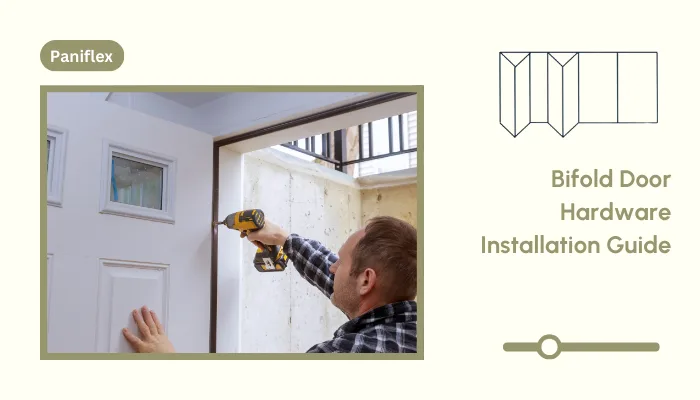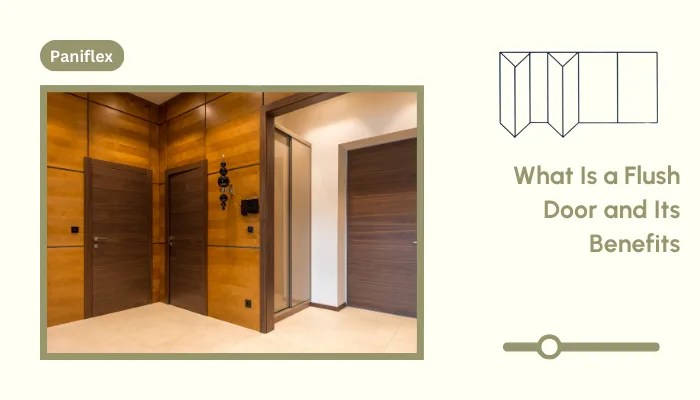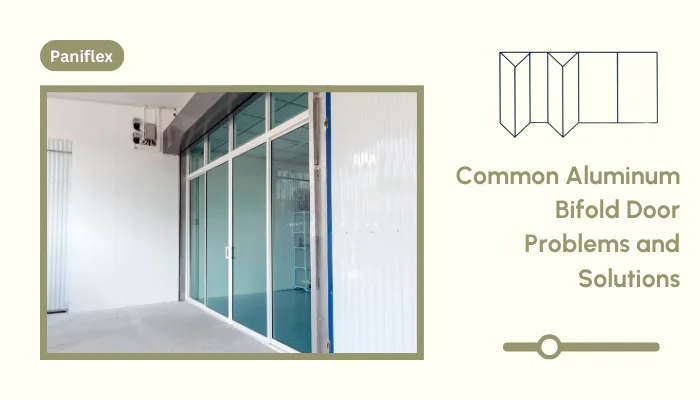Bifold doors maximize space efficiency and enhance aesthetics, but improper hardware installation leads to misalignment, excessive friction, and long-term operational failure. Precision at every step is essential.
One common issue professionals encounter is doors that stick, sag, or fail to align correctly due to improper track installation or pivot bracket placement. These problems compromise functionality and result in costly adjustments and callbacks.
Achieving a seamless, smooth-operating bifold door requires meticulous installation. This guide provides a structured, step-by-step approach covering track alignment, pivot placement, and fine-tuning for optimal performance. Every detail—from measuring to final adjustments—plays a crucial role in ensuring durability and flawless motion.
Ready to experience the benefits of custom closet doors? Explore our range of Paniflex products now.
Tools & Materials Needed
Accurate installation starts with the right tools and high-quality hardware. Using suboptimal components or incorrect tools increases the risk of misalignment and mechanical failure. Minor misalignments in the track or pivot brackets can cause doors to stick, drag, or operate unevenly.
You should ensure you have high-quality tools and durable hardware to prevent costly readjustments and long-term performance issues.
The following table outlines the essential tools required for a professional-grade bifold door installation.
| Tool | Purpose |
|---|---|
| Measuring Tape & Level | Ensures precise alignment of tracks and pivot brackets. |
| Drill & Screwdriver (Manual or Electric) | Secures brackets, tracks, and hinges without overtightening. |
| Chalk Line & Pencil | Marks alignment points for accurate hardware positioning. |
| Mallet & Wood Block | Protects door panels while tapping pivot pins into place. |
| Adjustable Wrench & Hex Key Set | Fine-tune pivot bracket tension and track adjustments. |
Commercial-grade tracks and pivot brackets ensure long-term durability. Opt for reinforced aluminum or steel tracks and load-bearing pivot systems designed for frequent use. Cheap or lightweight components often warp under stress, leading to premature failure.
Key hardware components needed include:
| Hardware | Function |
|---|---|
| Top Track System | Guides door movement. Must be level and securely fastened to prevent misalignment. |
| Pivot Brackets & Pins | Support door weight and enable smooth folding. Proper positioning ensures effortless operation. |
| Hinges | Connect door panels. Reinforced hinges prevent sagging and excessive movement. |
| Snugger Guides & Alignment Clips | Maintain door positioning and prevent excessive swinging. |
| Knobs or Pulls | Installed at the correct height for ergonomic and balanced operation. |
Using the correct tools and materials is essential for a successful bifold door installation. Professional-grade equipment improves accuracy, while high-quality hardware extends the door’s lifespan and enhances its functionality. Skimping on materials or using improper tools can lead to persistent alignment issues, excessive wear, and operational failure.
The next section covers pre-installation preparation, including measuring, leveling, and verifying hardware compatibility for a seamless setup.
Pre-Installation Preparation
Proper preparation is the foundation of a flawless bifold door installation. Skipping this step often results in misalignment, uneven door movement, and long-term operational issues. Before mounting any hardware, professionals must ensure accurate measurements, level surfaces, and proper clearances to accommodate smooth door operation.
Ignoring pre-installation steps can lead to costly rework, forcing adjustments that compromise door stability and performance.
1. Measuring the Door Opening
Precise measurements prevent poor door fit and restricted movement:
- Width: Measure the top, middle, and bottom; use the smallest measurement.
- Height: Measure both sides from floor to header; adjust track or pivot placement for discrepancies.
- Depth Clearance: Ensure enough space for the track system and door panels to fold without obstruction.
2. Checking for Level & Plumb
Uneven frames cause sticking and improper folding:
- Floor Leveling: Use a bubble level; install shims if needed.
- Plumb Jambs: Verify vertical alignment; adjust if necessary.
- Header Straightness: Ensure the top frame is perfectly level to avoid uneven track installation.
3. Verifying Hardware Compatibility
Using mismatched components affects door performance:
- Confirm Track Type & Size: Ensure compatibility with door width and weight.
- Check Pivot Brackets: Must support door weight and panel thickness.
- Inspect Hinges & Guides: Use heavy-duty, corrosion-resistant hardware.
Pre-installation preparation prevents alignment issues and mechanical failures before they arise. Precise measurements, level surfaces, and compatible hardware set the stage for a smooth installation. Investing time in this step eliminates common installation errors, reducing the need for later adjustments.
The next section covers the step-by-step process for installing the track system, ensuring a stable foundation for bifold door operation.
Step-by-Step Installation Process
A systematic installation process ensures smooth bifold door operation and long-term durability. Many installation errors stem from improper track placement, incorrect pivot bracket positioning, or insufficient adjustments after mounting.
By following a systematic approach, professionals can prevent common pitfalls and achieve a flawless installation.
Recommended Watch: For a visual guide to complement this installation blog, check out this step-by-step video.
Follow these steps to ensure a professional bifold door installation:
1. Installing the Top Track
- Mark the Placement: Use a level and chalk line to establish a straight guide along the header.
- Pre-Drill Holes: Drill pilot holes at marked points to prevent wood splitting.
- Secure the Track: Use manufacturer-recommended screws to fasten the track. Ensure it remains level to prevent uneven door movement.
- Install End Stops: Position end stops at both ends to limit door travel and prevent overextension.
2. Attaching the Pivot Brackets
- Bottom Bracket Placement: Secure the bottom pivot bracket at the designated side of the opening, ensuring it aligns with the track.
- Top Pivot Bracket: Install the top pivot bracket inside the track system, ensuring proper alignment for vertical stability.
- Guide Bracket Installation: To ensure controlled door movement, attach the guide bracket at the opposite end of the track.
3. Mounting the Door Panels
- Attach Hinges: Secure hinges between panels, leaving even spacing for smooth folding.
- Insert Pivot Pins: Insert the bottom pivot pin into the floor bracket and the top pivot pin into the track bracket.
- Adjust Door Alignment: Verify spacing and make fine adjustments using the pivot bracket screws to align doors evenly.
4. Final Adjustments & Testing
- Check for Smooth Operation: Open and close the doors multiple times to ensure effortless movement.
- Fine-Tune Pivot Pins: Adjust pivot tension to balance weight distribution.
- Lubricate Moving Parts: Apply a silicone-based lubricant to reduce friction and enhance longevity.
A structured installation process ensures bifold doors operate smoothly and remain stable over time. Proper track alignment, bracket placement, and precise door mounting prevent operational issues. Poorly installed doors lead to structural stress, frequent readjustments, and long-term mechanical failure.
By carefully securing the track, correctly placing pivot brackets, and adjusting the door alignment, professionals can guarantee optimal performance and durability. Even a well-installed bifold door may require slight adjustments after use. The next section covers common installation issues and how to resolve them for a flawless finish.
Common Mistakes & How to Avoid Them
Even experienced professionals can encounter installation issues if small details are overlooked. Common mistakes such as track misalignment, improper bracket positioning, or incorrect door spacing can lead to operational failures. Understanding these errors and implementing corrective measures prevents callbacks and ensures a seamless bifold door experience.
This section highlights the most frequent mistakes made during installation and provides practical solutions to avoid them.
Misaligned Track Installation
Issue: A slightly uneven track causes the doors to drag, stick, or fail to close properly.
Solution:
- Use a level before securing the track to ensure perfect alignment.
- Pre-drill holes to prevent track shifting during fastening.
- Double-check alignment after installation by opening and closing the doors multiple times.
Suggested Read: Having trouble adjusting misaligned bifold door hardware? This discussion explains how to reposition pivot brackets, secure track hardware, and ensure smooth operation.
Incorrect Pivot Bracket Placement
Issue: Improperly positioned pivot brackets cause misalignment, leading to uneven folding and structural stress.
Solution:
- Install pivot brackets exactly at the manufacturer’s recommended location for proper weight distribution.
- Verify that the bottom pivot pin is securely placed into the floor bracket.
- Adjust the pivot brackets slightly if the door panels don’t align correctly.
Uneven Door Panel Spacing
Issue: Panels are either too close, causing friction, or too far apart, creating unsightly gaps.
Solution:
- Use spacers or shims to ensure even panel gaps before final tightening.
- Adjust hinges incrementally to correct any spacing inconsistencies.
- Test the door’s movement and adjust as needed before securing all screws.
Over-Tightening
Issue: Over-tightened screws distort hardware, restricting smooth door movement.
Solution:
- Tighten screws just enough to hold hardware firmly in place without warping the material.
- Use a manual screwdriver instead of a power drill for final tightening.
Jamb Plumbness
Issue: An uneven floor or misaligned door frame causes doors to stick or swing improperly.
Solution:
- Check floor level before installation and use shims if necessary.
- Verify that side jambs are perfectly plumb before securing brackets.
- Make small adjustments to pivot placements to compensate for minor inconsistencies.
Avoiding these common mistakes ensures bifold doors function smoothly and require minimal future adjustments. Precision at every stage—track alignment, bracket positioning, and panel spacing—prevents performance issues and guarantees long-term durability.
Professional installation requires precision-engineered bifold doors and durable hardware to ensure smooth operation and long-lasting stability. This is where Custom Door & Mirror excels.
Why Choose Custom Door & Mirror?
Proper bifold door installation depends on technique and the quality of the hardware and materials used. Even the most precise installation cannot compensate for subpar components that warp, misalign, or degrade over time. Custom Door & Mirror (CDM) provides high-performance bifold door solutions engineered for durability, smooth operation, and aesthetic appeal.
Specifically-Crafted Hardware
Misaligned or poorly manufactured hardware leads to sticking, dragging, and long-term performance issues. CDM’s bifold door hardware is designed to exact specifications, ensuring:
- Reinforced aluminum and steel tracks that maintain their shape and alignment.
- Heavy-duty pivot brackets that prevent sagging and support long-term stability.
- Smooth-glide rollers and snugger guides for effortless operation with minimal maintenance.
Perfect Fit
Standard bifold doors often require modifications to fit specific openings, leading to gaps or forced adjustments. CDM offers doors that:
- They are custom-cut to precise dimensions, eliminating installation headaches.
- Feature high-quality hinges and pivot points, ensuring seamless folding and long-term reliability.
- Come in a range of styles and finishes to complement any architectural design.
Minimal Maintenance
Inferior bifold doors require frequent adjustments due to material warping or hardware failure. CDM’s solutions are built for longevity, featuring:
- Warp-resistant materials that maintain stability in varying conditions.
- Corrosion-resistant finishes for increased durability in high-humidity environments.
- Precision-engineered components designed for high-frequency use in residential and commercial spaces.
Choosing high-quality bifold door hardware and custom-fitted doors eliminates installation challenges and ensures flawless operation. Custom Door & Mirror provides professional-grade materials designed for seamless installation, long-term stability, and effortless performance.
Ready to experience the benefits of custom closet doors? Explore our range of Paniflex products now.
Conclusion
Installing bifold door hardware requires precision, high-quality materials, and a structured approach. By following a meticulous installation process, professionals can ensure smooth functionality, durability, and a flawless finish.
Beyond technique, hardware quality directly impacts installation success. By combining expert installation methods with high-performance materials, you can create bifold door systems that operate flawlessly for years to come.
Custom Door & Mirror provides precision-engineered bifold doors and durable components designed for effortless installation and long-term reliability. Investing in quality hardware and following best practices eliminates unnecessary adjustments.
Upgrade your next installation with superior craftsmanship. We make doors that fit perfectly. Contact Custom Door & Mirror today for premium-quality bifold door solutions!






